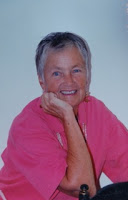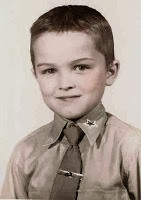“Exploration” and 8-year old boys naturally go together as it is part of a boy’s job description along with: mischievousness, recklessness, inquisitiveness, disobedience, playfulness, rowdiness, loud, annoying (“Are we there yet?”, and the ever popular “Why?” repeated ad nauseaum), seekers of anything remotely fun (especially if it involves dirt or mud). But the description also contains: loveable, unlimited energy, full of wonder at new things, dreamers, and the all powerful over riding (and indefinable) “cuteness factor.” It doesn’t matter from what background or environment or race or culture a boy comes from (as long as no one has beaten such characteristics out of him) all boys share this common job description.
My story actually has its roots in 1953 with my first day of kindergarten. My grandmother dressed me in old style “baby” clothes (that in her day were perfectly acceptable girlish styles for little boys) as often as she could. My mother wisely stopped that practice when I began school. Unfortunately, her choice of shoe styles did not match the opinions of other boys of the same age or older. I had to wear sandals with wingtip style little holes punched into the leather. That day I learned the word “sissy” and I did not like it. So, I pitched a fit (mostly crying) and my dad over ruled mother and I got normal shoes that very evening. Nonetheless, “sissy” did not disappear from other boys’ vocabulary when referring to me for the next three years (K-2).
Now enter 1956, I (a newly arrived 8-year old), was sent to live on my grandparents’ farm in central Minnesota while my parents (unbeknownst to me) were arranging their divorce. Suddenly, I had a whole farm to explore that summer (and ultimately), autumn, winter, and spring in rotation. Eighty acres of new frontier for the world’s greatest trapper ever known, to bring in beautiful animal pelts for the ladies back east to wear. (Okay, so they really weren’t buffalo or bear pelts, but if an 8-year old boy squints just right under the proper lighting conditions, gopher skins can look just like buffalo or bear hides.)
1956 was the year of my awakening to the expanded world of exploring everything on the farm: the barn, milk house, hayloft, silo, chicken coop (stay away from there—guarded by a vicious rooster; Hey! I was only 8 and the rooster was “big”), granary, workshop (nice adult stuff in there), equipment shed where various farm implements were stored until needed, and the outhouse (the stink you “enjoyed” twice a day). State and county fair time brought other places to explore: animal barns (varieties of chickens, pigs, cows, sheep, horses, etc.), judging of canning, 4-H, displays of quilts, new farm machinery (tractors, bailers, rakes, manure spreaders (yucky!), thrashers, and combines), and of course the midway (yea!!) in the evenings.
As summer waned and school began I met and made a few friends: two farm kids (one even in my third-grade class); and several “townies” (my best townie friend was the son of the high school football coach). I also discovered that one of my dad’s brothers and two cousins also were townies. I had ridden school busses for three years in Los Angeles so that was not new. One of my farm friends and I were part of the “space race” as we would design rocket ships every evening and then compare them on the bus ride to school the next morning. (Hmmmmm. Could that have been early “training” to enjoy phallus shaped things?) Another farm boy and I did a bit of exploration of another type while riding the bus to school with our coats covering our crotches (use your imagination—and “No” we never got caught).
Another school-yard “exploratory” activity involved games. One favorite among all students (townies and farm boys) was marbles. Our version involved scooping out a shallow depression next to the wall of the school, placing the marbles we wanted to risk (bet) into the depression, and then stepping back a distance (which increased with each turn) and attempting to roll a “shooter” into the depression so it stayed. If more than one boy’s shooter stayed in, the two “winners” would roll again from a greater distance and repeat the process until there was only one shooter in the depression. The winner would then collect all the marbles in the hole and the betting process would begin again. Sadly, I don’t remember the name of this game.
The second game we called Stretch. I can’t speak for the townies, but all self-respecting farm boys had a small pocket knife in one of his pockets all the time (including at school). [Can’t do that today due to fear of violence in schools.] In this game two boys would face each other and one would start by throwing his knife at the ground at a distance calculated to be beyond the reach of the other boy’s leg. If the knife didn’t stick, it was retrieved, and the other boy took his turn. If the knife stuck, the other boy would have to “stretch” one leg/foot to touch the knife all the while keeping the other leg/foot firmly in place where he had been standing. If he was successful in touching the knife without moving the other foot, he retrieved the knife, returned it to its owner, and then took his turn of throwing the knife. If he could not touch the knife, he lost the game and another boy would take his place challenging the winner.
The third and fourth games were “King of the Hill” and snowball fights (obviously reserved for winter recess). I trust I don’t need to describe these. With all of these games, I (we) were “exploring” our limits or increasing our skills.
The elementary part of this school was of the old style, a “square” three story edifice with one classroom located at each of the corners of the first two floors and storage rooms on the third floor. The restrooms were in the basement and (miracles of miracles) the rope to ring the bell up in the cupola on the roof ran all the way into the boys’ restroom. “Yes,” even during a pee break (raise one finger and wait for permission) I would occasionally “just have to” “explore” pulling on that rope and then run back to class (remember the job description—mischievous).
Anyway, 1956 is when the “sissy” got lost and I became all boy.
© 26 March 2011
About the Author
I was born in June of 1948 in Los Angeles, living first in Lawndale and then in Redondo Beach. Just prior to turning 8 years old in 1956, I began living with my grandparents on their farm in Isanti County, Minnesota for two years during which time my parents divorced.
When united with my mother and stepfather two years later in 1958, I lived first at Emerald Bay and then at South Lake Tahoe, California, graduating from South Tahoe High School in 1966. After three tours of duty with the Air Force, I moved to Denver, Colorado where I lived with my wife and four children until her passing away from complications of breast cancer four days after the 9-11 terrorist attack.
I came out as a gay man in the summer of 2010. I find writing these memories to be therapeutic.
My story blog is TheTahoeBoy.Blogspot.com



